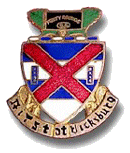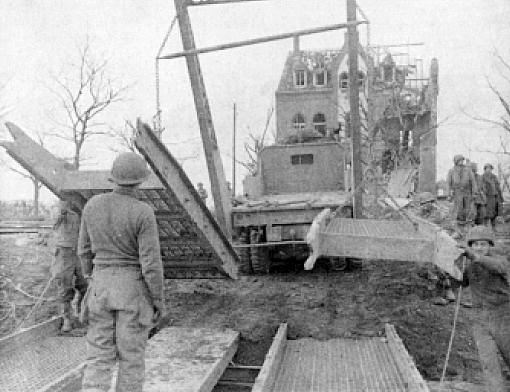(8th INFANTRY DIVISION) IN THE ATTACK ON DÜREN, GERMANY,
AFTER THE CROSSING OF THE ROER RIVER,
23 - 25 FEBRUARY 1945
(RHINELAND CAMPAIGN)
By Captain Alexander F. Berol

THE CROSSING OF THE ROER RIVER
The artillery lifted from the east bank and water front buildings at 0330 hours when the initial units of the 3d Battalion, platoons of I and K Companies, shoved off from the west bank of the ROER RIVER in engineer assault boats powered with outboard engines. These motors were to have been warmed up during the preparation but many failed to start, so the first wave saw some transported by power boat, and some going across under the power of paddle wielded by the infantry. German mortar and artillery fire raked the east bank and the river, knocking out boats, causing casualties and generally raising havoc with our troops. 20
The first wave saw one officer per company, each with approximately half of his platoon across the river where they deployed into a few buildings on the river bank. 21
The return trip was even more disastrous to the engineer boats as practically all were either swept downstream where they either crashed into pilings of a knocked-out bridge, that formerly connected DÜREN with RÖLSDORF, or were swept into the sector of the 104th Division where many men were rescued. This left the small first wave the bridgehead for the 3d Battalion, 13th Infantry. 22
During the balance of the morning, until daylight, constantly under heavy enemy fire, frantic efforts were made to cross the ROER by the use of cables stretched across the river to guide the few remaining assault boats. These experiments helped cross the balance of the platoon of I Company and almost a full platoon of K Company before they were knocked out. 23
Daylight on 23 February saw these two small portions of the battalion across and that's all, because as soon as it was daylight the fire controlled from observation points made it all but impossible to operate along the river. Attempts were made to bridge the river, but they proved disastrous, as no one could, under these conditions, accomplish any mission. It was during this time Lieutenant Colonel Leonard S. Wilhelm, Commander of the 3d Battalion was killed. 24
During the day of 23 February the units in DÜREN were forced to do the job intended for a battalion as no help other than fire support could be given them. L Company, the balance of the battalion and all service units spent the day under a cover of smoke from 4.2 mm mortars, in getting more equipment ready to cross the river as soon as darkness fell. One idea was introduced of using a flying ferry operating on a cable utilizing the river current as a means of power, as an expedient. 25
As soon as darkness fell the operation of river crossing started again to get troops across both by boat and by the new method of a flying ferry. This expedient worked so well that by 2200 hours the 3d Battalion was on its way. The balance of I and K Companies were crossed to assist their elements and to forge ahead in the attack on DÜREN. 26
These companies were followed by Battalion Headquarters which set up its Command Post in what was left of a building near the former main highway bridge into the city. 27
L Company still in battalion reserve crossed after the Battalion Headquarters Group. As portions of it crossed the river it gradually formed a unit in a reserve area in rubble of buildings near the Battalion Command Post. Shortly after L Company crossed the VII Corps engineers had completed construction of a bridge into the city. This bridge was under construction for over ten hours, a job which normally would have been completed in two or three, so severe was the accurate shelling of this area.

Engineers attached to the 8th Division rush to completion the first pontoon bridge
in the vicinity of Düren, Germany, across the Roer River.
This work was done under fierce fire from the enemy.
With the crossing of the entire battalion and the completion of the bridge, just about twenty-four hours behind schedule, all were set to really enter and clear the western section of the city and proceed to the regimental objective, the railroad running northwest to southeast on the eastern side of the City of DÜREN. 28

